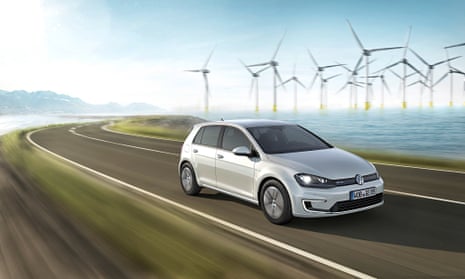A freeway in California, late afternoon rush hour. Most of the traffic is doing 65mph; I’m in a new electric VW eGolf at the end of a long drive and the dashboard tells me I have zero miles of range left. Zero miles. I’m just one week into electric car ownership and already mischievously seeing how far I can push it – and in a few more miles that may be literal.
The car kicks into emergency mode, the ominous glowing tortoise of doom appears on the dash and the car slows to 25mph. I crawl off at the next junction.
Knowing there will be a good chunk of “secret” reserve energy hidden behind that zero, I find a lay-by and look for the nearest Volkswagen dealership. They will have at least a level two charger that will give me enough charge to get home in about half an hour. In an age when time is at a premium, the exchange of time for charge is the biggest cost of electric vehicle ownership.
Then again, my previous charge was at Doran Beach Road, which is, as it sounds, a car park on a beach. I plug in, then have to wait on a golden sandy beach for an hour while my car charges. Like a lesson in learning to appreciate the moment, I can’t go anywhere. There are no shops. There is no food. I must stay on the beach, in the sun, and wait. There’s some satisfaction, then, in that exchange of time for charge.
So far this year, 72,270 electric vehicles have been sold in the US but here’s where the characteristic complexity of the electric vehicle world kicks in. Many of those vehicles aren’t zero-emission, but hybrid engines or plug-in hybrids which still heavily rely on combustion engines to do their dirty work.
California has ambitious goals for cutting emissions. The state wants one million zero-emission vehicles in service by 2023, while Barack Obama’s administration has already admitted that it won’t meet its own 2011 target of one million zero-emission cars by the end of 2015. There are somewhere in the region of 250 million gas-guzzling vehicles in the US alone.
And when you attempt to buy an electric vehicle, you start to see why. We had done our homework and went to test drive a Volkswagen eGolf. It was a revelation – a gentle hum from the battery as the car pulled away, the battery in the floor makes the car feel glued to the road around corners at speed and, best of all, instant acceleration that sticks your head to the seat rest.
The only thing on the sales guy’s mind was selling the car, but he was in such a rush he didn’t have time to find out what he was selling. The cable that comes with the car will charge it at home in four hours he said; later we work out that it’s a 110v cable that will take up to 22 hours. There was no mention of the California customer tax rebates of up to $7,500 (£4,800) – in fact he told us the cardealers took the whole rebate themselves – an astonishing omission in what is supposed to be a major selling point for electric cars in California. And when I suggested turning the aircon off to make the battery last longer, he threw back his head and laughed; later I read that the car’s economy driving mode does exactly that, turning off aircon to extend the car’s range.
The cultural divide between EVs and gas guzzlers is big and ugly. Information online is patchy and scattered and takes intensive, committed research. Car dealers are largely ignorant, allocating junior staff to their electric vehicle sales. A friend attempting to buy a BMW i3 back in the UK ended up having to brief the sales guy about the sustainably-grown bamboo trim and the BMW factory powered by wind turbines.
After-sales service is very poor; customers are left to research the complexities of installing at-home charging units (there are three levels of charging, multiple makes of the fastest domestic charger, and dealers have no idea which electrician to recommend to install one. All this should all be included and arranged as part of your new vehicle).
Once you’re on the road and need to charge, charging stations are all proprietary, so you can’t pull up, charge and pay with a credit card. You need to sign up for an account and use a branded swipe card that usually takes 10 days to come in the post. Don’t even think of running out of smartphone battery or you’ll have no hope of finding a charging point at all.
Despite all this, electric vehicles really are worth the demands of time and research placed on their new owners. But until the process becomes easier, electric vehicles will remain out of reach of those targets, and out of reach of all but the most committed electrafarians. Given how impressive this technology already is and how fast it is improving, that’s a real shame, because these cars are a delight to drive. Whatever the learning curve, and however much we will need to change the rituals of our road trips, the best thing is an overwhelming wave of calm satisfaction that comes from knowing the vehicle you drive is clean, and feels like the future.

